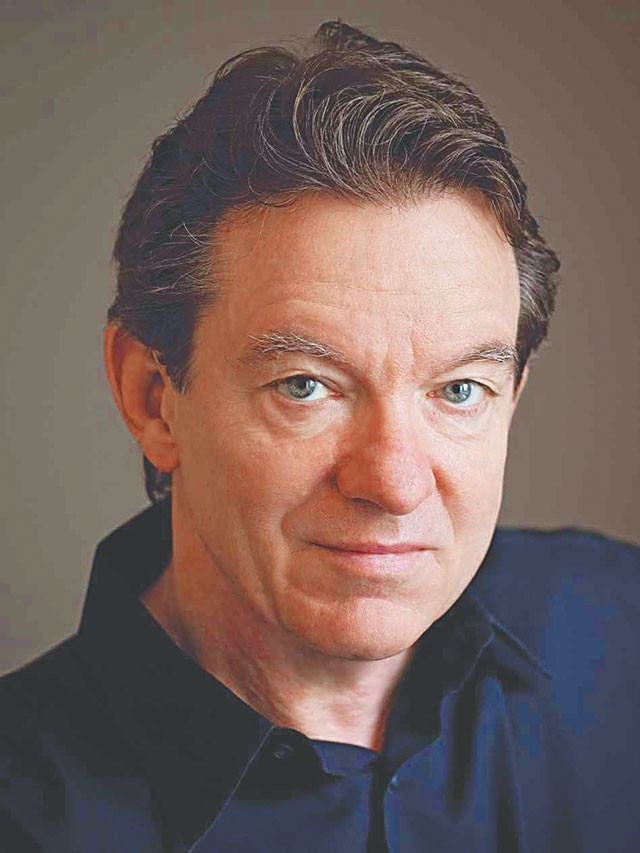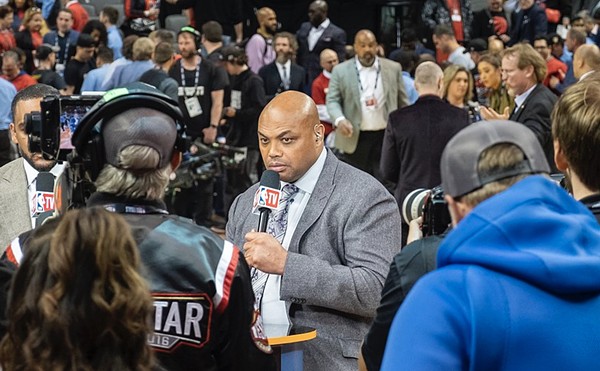Going Clear: Scientology, Hollywood, and the Prison of Belief
Moderator: Robert Rivard
In his newest book, Going Clear, Austin-based journalist Lawrence Wright profiles Scientology, a new American religion that, while ubiquitous among the Hollywood elite, has a long, strange dark side. Read the full Q&A below to learn more about Wright's work (read our review of Going Clear here), including his Pulitzer-Prize winning book about al-Qaeda, The Looming Tower. See him talk about Scientology, al-Qaeda, and the power of religion at the book festival this weekend. 11-11:45 a.m., Festival Room, Central Library.
Interview with Lawrence Wright
By Michael Barajas
Why the theme of religion and faith throughout your work?
I was very a religious teenager, although I moved away from that later in life. As a reporter, I was always struck by the power of religious beliefs to shape the behavior of individuals and societies for ways both good and ill. And I began considering how politics is something that we reporters devote ourselves to so avidly. But one can hold powerful political beliefs without actually changing one's behavior. It's not so easy to do that with religious beliefs. I think that they are far more influential in people's lives than we journalists give credit for.
What's your religious background?
I grew up in a Methodist church in Dallas, but I was also involved in a Christian youth movement in high school.
Are there elements from those experiences that you've gone back and investigated or reported on?
I did a book called Saints and Sinners on people from different religious backgrounds. It included very esoteric people like Anton LaVey, the founder of the Church of Satan, and Madalyn Murray O'Hair, the famous atheist here in Austin. But I also wrote about Walker Railey, who was minister of the church were I grew up in Dallas, the First United Methodist Church. He eventually strangled his wife into a coma, she lingered for like 15 years until she died recently. So all those stories are a part of that book. Religious themes have always popped up in my career.
Is there a personality, a psychology you've identified for individuals who amass a group of followers or for those who can truly devotes themselves to a religion?
Well, what I'm doing in Going Clear is really analyzing what I call the process of belief. In the case of Scientology, it's not a conversion experience. It just doesn't happen that way. But it's the movement of a personality, such as Paul Haggis, one of the characters featured in my book, who's a skeptical, intelligent person — The movement that he goes through from being a non-believer to being a believer then to again becoming a non-believer. For me, it's a way of analyzing how faith and belief systems come to be adopted. And that process is something that happens to all of us in one way or another. That really interests me because it is a very human experience. And that's how our societies are shaped, by individuals or groups coming to believe different things, like religious of political beliefs.
You write this scene where Paul Haggis is brought in to read the deepest, darkest secrets of his religion, where he finds out about all the Xenu and space opera stuff. His reaction, which seems reasonable, is “This stuff is crazy.” Why do they stay in, especially after hearing those parts of Scientology's belief system?
Scientology is not unique in having an extremely esoteric belief system. Religion is irrational. It's almost the definition of it. New religions such as Scientology certainly bear a higher mark than other religions because they're not consecrated by time. Most of the dominant religions in the world were founded at a time when there were not investigative reporters and television. They got the benefit of not having the scrutiny that we give to new belief systems now.
With Scientology, there are two things. One is they may believe it. There may be people in Scientology who avidly endorse the belief system that makes up the faith. Tom Cruise is a notable example. And then there are other people like Paul Haggis who may not swallow it, but who remain a part of the religion for other reasons. A belief system is what separates a religious community from the rest of society. And if you say, “I believe this,” you cross a line into a community of people who agree with you or at least say they do. With Scientology, like many other religious communities, it's a very supportive, but closed environment. Many people, like Paul Haggis, have their friends inside that circle. Their family are involved with it. They've given a lot of money. They've made public declarations of their belief. It's not so easy to step outside of that circle once you're inside of it. And they're often times rewarded by their involvement. Many people I talked to said they got a lot out of Scientology. People go into Scientology often times because they have some personal problem they want to address, and Scientology offers a menu of courses that may help. Jerry Seinfeld still credits Scientology with helping him gain the confidence to become a standup comedian by taking one of their communications courses. That kind of report is really common. In addition, Scientology has a form of therapy called auditing, and sometimes people feel they've gotten something out of it. One of the things that people report very commonly is they've discovered past lives during the auditing process. That's good news to a lot of people, that they've lived before and that they'll live eternally. That’s very appealing.
What little familiarity I have with Scientology's dark side came from Debbie Cook's court hearing here last year – claims the church kidnapped, imprisoned, mentally and physically tortured people. How common is this behavior, and how and why did it start?
It's confined to the clergy of Scientology, which is called the Sea Org. And the church has these re-education camps for members of their clergy in various places around the world. But at the international headquarters of the Sea Org, which is a compound in Southern California in the desert, there is one of these re-education camps comprised of two double-wide trailers and called “the hole.” And in 2006, (David) Miscavige, the leader of the church, began confining some of his top executives in these trailers. He had all the furniture removed, so they slept on the floor. At one point there were more than 100 of these Scientology executives confined in “the hole.” The level of abuse that went on there was really extraordinary. I was just stunned when I started interviewing people about their experiences inside that and how grotesque it became, especially for a religion. The physical and verbal and emotional abuse that took place was so degrading. And it certainly reflects poorly on the church itself that they allowed this kind of thing to happen.
But physical abuse and confinement, involuntary confinement, that's something that has been a part of the Sea Org since it was first formed on this Scientology fleet that L. Ron Hubbard created in the middle-1960s. And he himself ordered children, even, to be confined in anchor chain lockers for days and weeks at a time. That's where this idea of forcible punishment took root and, I think, if you wanna find the DNA of this kind of abusive system, it goes back to the days on the Apollo, the ship that Hubbard commanded.
Some of the more fascinating portions of this book are where you profile L. Ron Hubbard – how he was influenced by post-war paranoia, a growing counter-culture movement. How was Hubbard a product of his time?
With Hubbard, there are these two narratives to his life. There's the narrative that he put forward that he was a war hero, and that he was injured during the war. That he was badly crippled and blinded, and that medical science was unable to heal him and so he healed himself using these techniques that he developed into Dianetics. At that time, there were a lot of wounded veterans, and there was an awful lot of trauma that was left over from the war. So when he wrote the book Dianetics that was published in 1950, the scars of the war, both emotional and physical, were still very evident. And this book took off like crazy. It was a nation-wide sensation, an international sensation. It dominated The New York Times best sellers list. It in many ways created the prototype for those self-help books that became so prominent after World War II. In that sense, Hubbard was progenitor of the form.
But he was also very influenced by Freud and also by his experience in the black magic circle of southern California that had sprung out of Aleister Crowley's work. So he was both a product and his time and a formulator of what was going to come later.
The narrative that he put forward about himself is, of course, not substantiated by the facts, but it is the basis of the church's claim that this was all based on the ability of a single human being. That L. Ron Hubbard overcame these physical injuries that he, in fact, didn't actually sustain during the War in the first place.
You write about this strange scene where some Scientology reps came to the New York to fact-check the original New Yorker article on Paul Haggis. What was their response to your reporting that their history of Hubbard was false?
That day when the Scientology spokesman and four of their lawyers came to The New Yorker was one of the most extraordinary days in my whole journalistic career. It was my only chance really to interview the spokesperson for the church. They had originally agreed to let me. Tommy Davis, the church's then-spokesman, invited me come over Memorial Day weekend in 2010 so we'd have enough time for him to take me through Scientology. I got out there and after cooling my heels in the hotel for a couple nights without any word from him, he finally showed up and said he wasn't going to do that.
He did agree to respond to fact-checking queries. I don't know if he had any idea what that meant in The New Yorker terms, but our first volley of queries was 971 questions about the material. And that's what triggered the trip to New York by the Scientology delegation. They brought along 47 binders of material that was supposed to be in response to our fact checking queries. The day was spent going through their responses, which were incomplete in many cases. Tommy pulled out a pie chart showing something like 68 percent of the questions were, as he put it, “false.” That was strange, because they were just questions. But a lot of that day was spent trying to understand how the church had parsed their responses, which were very carefully worded.
When the (New Yorker) article came out, the church published its own magazine – they have this magazine called Freedom. My article in The New Yorker had come out in the anniversary issue on Valentines Day, which, the cover is always this replica in some way of the original cover, with the man in the top hat and monocle which is known as Eustace Tilly. And in the Freedom magazine, they had a cartoon version of Eustace Tilly with me as Eustace. There was a delegation of Scientologists picketing the Condé Nast building in Times Square, passing out copies of Freedom magazine with an attack on me, The New Yorker, and even the fact checkers on the story.
Then, with the book, there were a number of legal threats. And when the book finally did come out, the church attacked it repeatedly. Some of their claims are just quite bizarre. For instance, they said that I only asked 12 fact-checking questions of the Church. Even just the very first letter to the Church had 971. And after the article came out, I hired two fact checkers, one of them devoted mainly to the Church. We asked more than 150 fact-checking questions then. The Church told us they needed seven working days for each question, which would have required something like three years to respond.
When they knew that I was going to be on a television show or something where I'd be talking about Scientology, their lawyers would often contact the show's producers with legal disclaimers they wanted to have read. The strangest one was when I was on Christiane Amanpour. She asked me about Operation Snow White, which was Scientology's infiltration of various agencies in the United States government, such as the Justice Department, the FBI, the IRS, and even the Food and Drug Administration. It was even newspapers like the Washington Post, organizations like the American Mental Health Association, and other governments like Germany. More than 5,000 scientologists were deployed in this spy operation.
Christiane was obliged to read this statement from the Church of Scientology saying this was simply an “information gathering” adventure and no laws were broken. And I responded, “Well, 11 people went to prison, including the wife of L. Ron Hubbard. I would dispute that assertion.” Several times made allegations or assertions that just have no basis in fact.
Switching to your book The Looming Tower, how did you come to this theme throughout the book, that vision or charisma of a few individuals really shaped the nature of this clash between Islam and the West?
One of the things that I addressed in The Looming Tower was whether al-Qaeda would have arisen had it not been for Osama bin Laden. And the answer is no. In this case, historians often debate whether it's individuals or social trends that shape history. It's certainly true that both of them do. There was a trend of increasing radicalism in Islam that preceded the rise of Osama bin Laden. But without his money and his vision and his idea of attacking the West rather than individual regimes within the Muslim world, al-Qaeda would have never been able to exist. Frankly, it's struggling to exist without him. We would not be dealing with Islamic terrorism to the degree that we've experienced it if it weren't for Osama bin Laden individually.
















